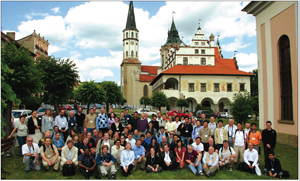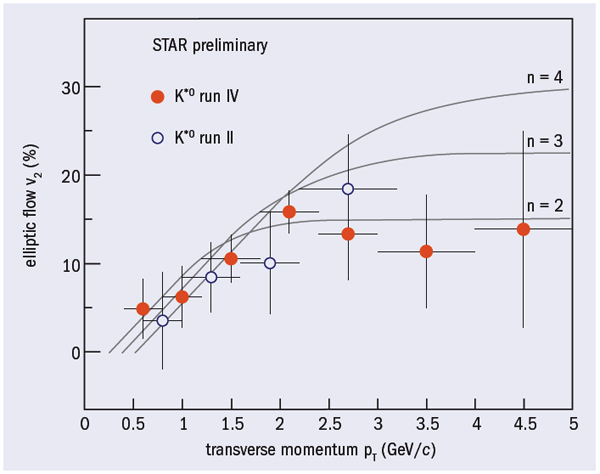SQM 2007 meeting hears of new results and expectations for the LHC.
The International Conference on Strangeness in Quark Matter, SQM 2007, took place on 24–29 June in the charming old town of Levoc̆a, located in Spis̆ in north-eastern Slovakia. Organized by the Institute of Experimental Physics of the Slovak Academy of Sciences, Kos̆ice, it was the 12th in a well-established series of topical conferences that bring together experts working in particle physics, nuclear physics and cosmology. More than 100 scientists from 20 countries took part this year, and the contributions covered a wide range of issues, from the bulk properties of the partonic matter created in nucleus–nucleus collisions, to the energy loss of fast partons traversing the medium, with a particular emphasis on the perspectives for the future.

Image credit: F Brincko, Levoc̆a.
The SQM series is currently dedicated to understanding what the production of strange – and also charm and beauty – particles can reveal about the hot and dense partonic matter formed in a high-energy nucleus–nucleus collision. It could perhaps more appropriately be called Strangeness, Charm and Beauty in Quark Matter. However, because of tradition, the original name has stuck. The extension to flavours heavier than strangeness has occurred naturally over the years as the high energies available at RHIC (and expected at the LHC) have turned charm- and beauty-flavoured particles into practical and promising probes for exploring QCD matter. On the experimental side, the challenge of detecting strange, charm and beauty particles is similar – although more difficult with charm and beauty – as the complete identification of all of these types of particle relies on identifying their decay products and decay vertices. Hence the need for similar techniques with the three flavours, both for the apparatus (high-granularity vertex detectors) and for the analysis. The SQM conferences therefore provide an excellent forum for researchers in this field to exchange not only physics results, but also information on experimental techniques and analysis methods.
There were more than 70 theoretical and experimental contributions this year, including review talks and reports from all of the active experiments at Brookhaven’s RHIC (BRAHMS, PHENIX, PHOBOS and STAR), at CERN’s SPS (CERES, NA49, NA57 and NA60) and at GSI’s heavy-ion synchrotron, SIS (FOPI). As the start-up of the LHC is just around the corner, more contributions than ever illustrated the plans for physics at future facilities. There were presentations on ALICE, the LHC experiment dedicated to heavy-ion physics, and the heavy-ion programmes for ATLAS and CMS and on the experiment on compressed baryonic matter (CBM) that is planned at the Facility for Antiproton and Ion Research at GSI.
The first day was devoted to a symposium where graduate students and post-doctorates had the opportunity to present their research results. Before the summary talks on the last day, a brief commemoration took place in honour of Maurice Jacob. He was a leader in the theory of high-energy hadron physics, a strong supporter of heavy-ion physics and a friend to many of us. He passed away on 2 May and we are all sorry that he did not live to enjoy the LHC’s results.
Hadronization and fragmentation
The bulk of the observed hadrons with low transverse momenta (pT < 2 GeV/c) are produced from matter that seems to be well-equilibrated by the time it dresses up into hadrons. In other words, statistical hadronization models reproduce hadron yields and ratios well, and in terms of only a few fitted -parameters, such as temperature and chemical potentials. A robust collective flow accompanies this equilibration. In non-central collisions, the spatial azimuthal asymmetry of the initial state transfers very efficiently to a momentum asymmetry of the final state. In a hydro-dynamical description, an “elliptic flow” of this kind – generated at the early stages of the expansion – gives access to the equation of state of partonic matter. The combination of hydrodynamics and statistical hadronization leads to a reasonable parameterization of the low-pT hadronic spectra and elliptic flow.

Many of the theory presentations dealt with the understanding of relativistic hydrodynamics and of the quark matter equation of state. Among several new results on the experimental side, we note that the RHIC data on copper–copper collisions at 200 GeV show enhancements of the Λ, Ξ, anti-Λ, anti-Ξ and Φ-meson with respect to proton–proton collisions. These enhancements are similar to those found (at a given number of participant nucleons) in gold–gold collisions at the same energy and in lead–lead collisions at the energies of CERN’s SPS.
The presence of the medium appears to modify fragmentation functions, which describe the dressing up of partons into final state particles. At high pT, the fragmentation of the parent parton is the dominating process. At intermediate pT (2 < psub>T < 6 GeV/c), however, the valence quark recombination or coalescence seems to play an important role. As a result, hadron production cannot be considered to be either thermal or perturbative, since the medium interferes with the hadronization process. For example, if hadrons are formed by recombination, the features of the parton spectrum are shifted to higher pT in the hadron spectrum – and in a different way for mesons than for baryons.
In this context interesting new results on K* production were presented. The azimuthal asymmetry of these particles corresponds to that expected from the recombination of two valence quarks. This would occur if coalescence of a valence quark–antiquark pair forms the K*. This is in contrast to what would happen if the K* were produced in the hadronic phase by combining a K and a π, each formed from a valence quark–antiquark pair, therefore requiring the recombination of four valence quarks (figure 1).
Fast parton energy loss
Strong quenching of hadrons with large transverse momentum (pT > 6 GeV/c) is another striking phenomenon, first observed at RHIC. The high-pT partons generated in hard scatterings at the initial stages of the nucleus–nucleus collisions do not fly away and hadronize freely. Instead, the nearby matter seems to largely absorb them. High-pT photons instead remain essentially unaffected, leading to a picture of a dense medium that is opaque to partonic, coloured projectiles but relatively transparent to photons.
Vigorous theoretical and experimental efforts are under way to understand parton energy loss in terms of perturbative QCD (pQCD). Various groups have described the suppression of light hadrons in terms of radiative energy loss by gluon bremsstrahlung. According to such calculations, charm and beauty quarks should be absorbed significantly less than light quarks and gluons. However, data from the PHENIX and STAR experiments, which compare the production in nucleus–nucleus and proton–proton collisions of high-pT “non-photonic” electrons (thought to originate mainly in heavy-flavour decays), seem to indicate that heavy quarks lose energy as much as light quarks do.

Image credit: A Dirner, Kos̆ice.
There were many contributions devoted to this puzzle at SQM 2007. Attempts to reduce disagreement by including elastic-scattering losses in addition to the radiative ones are being considered. On the experimental side, participants stressed the need to separate out the fraction of electrons coming from the decay of beauty hadrons, since b quarks are expected to lose even less energy than c quarks. Another important experimental caveat concerns the distribution of heavy quarks among the different heavy-flavour hadron species. This could change when going from proton–proton to nucleus–nucleus collisions, leading to pT-dependent variations of the semi-electronic branching ratios. Such an effect should obviously be kept under control when comparing electron production in nucleus–nucleus and proton–proton collisions. Some groups are making useful attempts in these directions by identifying the charmed meson D0 from the reconstruction of its decay. However, vertex detectors such as those of the LHC experiments are necessary for pursuing these studies further.
The fate of the energy deposited by the partons along their path also turns out to be non-trivial. It appears as though the partons’ propagation gives rise to some collective hydro-dynamical motion. Among the contributions on this subject, there was an interesting study of the response of the medium to energy loss, by analysing two- and three-particle correlations. The results seem to indicate a peak in particle production on a cone at an angle of about one radian from the direction of the propagating parton. A possible explanation would be the generation of a shock wave in the medium. The answer to this and many other questions will probably have to wait for the LHC data. We hope that there will be some to discuss at the next two conferences in this series being held in Beijing (2008) and Rio de Janeiro (2009).







